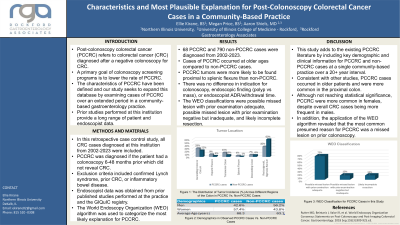Sunday Poster Session
Category: Colorectal Cancer Prevention
P0445 - Characteristics and Most Plausible Explanation for Post-Colonoscopy Colorectal Cancer Cases in a Community-Based Practice
Sunday, October 27, 2024
3:30 PM - 7:00 PM ET
Location: Exhibit Hall E

Has Audio
- EK
Ellie L. Kirane, BS
Northern Illinois University
Bowling Green, OH
Presenting Author(s)
Aaron Shiels, MD1, Megan Price, BS2, Ellie Kirane, BS3
1Rockford Gastroenterology Associates, Rockford, IL; 2University of Illinois College of Medicine, Loves Park, IL; 3Northern Illinois University, Bowling Green, OH
Introduction: Post-colonoscopy colorectal cancer (PCCRC) refers to colorectal cancer (CRC) diagnosed after a negative colonoscopy for CRC. A primary goal of colonoscopy screening programs is to lower the rate of PCCRC. The characteristics of PCCRC have been defined and our study seeks to expand this database by examining cases of PCCRC over an extended period in a community-based gastroenterology practice. Prior studies performed at this institution provide a long range of patient and endoscopist data.
Methods: In this retrospective case control study, all CRC cases diagnosed at this institution from 2002-2023 were included. PCCRC was diagnosed if the patient had a colonoscopy 6-48 months prior which did not reveal CRC. Exclusion criteria included confirmed Lynch syndrome, prior CRC, or inflammatory bowel disease. Endoscopist data was obtained from prior published studies performed at the practice and the GIQuIC registry. The World Endoscopy Organization (WEO) algorithm was used to categorize the most plausible explanation for PCCRC.
Results: 68 PCCRC and 790 non-PCCRC cases were diagnosed from 2002-2023. Cases of PCCRC occurred at older age compared to non-PCCRC cases (68.3 +/- 1.1 vs 63.1 +/- 0.5 years, p=0.001). PCCRC occurred more commonly in females than non-PCCRC cases, but this did not reach statistical significance (39/68, 57.3% vs 346/790, 43.8%, p=0.11). PCCRC tumors were more likely to be found proximal to splenic flexure than non-PCCRC cases (36/68, 52.9% vs 251/790, 31.8%, p=0.004). There was no difference in indication for colonoscopy, endoscopic finding (polyp vs mass), or endoscopist ADR/withdrawal time. The WEO classifications were possible missed lesion with prior examination adequate (49/67, 73%), possible missed lesion with prior examination negative but inadequate (9/67, 13%), and likely incomplete resection (9/67, 13%). There were no cases of a detected lesion that was not resected.
Discussion: This study adds to the existing PCCRC literature by including key demographic and clinical information for PCCRC and non-PCCRC cases at a single community-based practice over a 20+ year interval. Consistent with other studies, PCCRC cases occurred in older patients and were more common in the proximal colon. Although not reaching statistical significance, PCCRC cases were more common in females, despite overall CRC cases being more frequent in males. In addition, application of the WEO algorithm revealed that the most plausible explanation for PCCRC was a missed lesion on prior colonoscopy.
Disclosures:
Aaron Shiels, MD1, Megan Price, BS2, Ellie Kirane, BS3. P0445 - Characteristics and Most Plausible Explanation for Post-Colonoscopy Colorectal Cancer Cases in a Community-Based Practice, ACG 2024 Annual Scientific Meeting Abstracts. Philadelphia, PA: American College of Gastroenterology.
1Rockford Gastroenterology Associates, Rockford, IL; 2University of Illinois College of Medicine, Loves Park, IL; 3Northern Illinois University, Bowling Green, OH
Introduction: Post-colonoscopy colorectal cancer (PCCRC) refers to colorectal cancer (CRC) diagnosed after a negative colonoscopy for CRC. A primary goal of colonoscopy screening programs is to lower the rate of PCCRC. The characteristics of PCCRC have been defined and our study seeks to expand this database by examining cases of PCCRC over an extended period in a community-based gastroenterology practice. Prior studies performed at this institution provide a long range of patient and endoscopist data.
Methods: In this retrospective case control study, all CRC cases diagnosed at this institution from 2002-2023 were included. PCCRC was diagnosed if the patient had a colonoscopy 6-48 months prior which did not reveal CRC. Exclusion criteria included confirmed Lynch syndrome, prior CRC, or inflammatory bowel disease. Endoscopist data was obtained from prior published studies performed at the practice and the GIQuIC registry. The World Endoscopy Organization (WEO) algorithm was used to categorize the most plausible explanation for PCCRC.
Results: 68 PCCRC and 790 non-PCCRC cases were diagnosed from 2002-2023. Cases of PCCRC occurred at older age compared to non-PCCRC cases (68.3 +/- 1.1 vs 63.1 +/- 0.5 years, p=0.001). PCCRC occurred more commonly in females than non-PCCRC cases, but this did not reach statistical significance (39/68, 57.3% vs 346/790, 43.8%, p=0.11). PCCRC tumors were more likely to be found proximal to splenic flexure than non-PCCRC cases (36/68, 52.9% vs 251/790, 31.8%, p=0.004). There was no difference in indication for colonoscopy, endoscopic finding (polyp vs mass), or endoscopist ADR/withdrawal time. The WEO classifications were possible missed lesion with prior examination adequate (49/67, 73%), possible missed lesion with prior examination negative but inadequate (9/67, 13%), and likely incomplete resection (9/67, 13%). There were no cases of a detected lesion that was not resected.
Discussion: This study adds to the existing PCCRC literature by including key demographic and clinical information for PCCRC and non-PCCRC cases at a single community-based practice over a 20+ year interval. Consistent with other studies, PCCRC cases occurred in older patients and were more common in the proximal colon. Although not reaching statistical significance, PCCRC cases were more common in females, despite overall CRC cases being more frequent in males. In addition, application of the WEO algorithm revealed that the most plausible explanation for PCCRC was a missed lesion on prior colonoscopy.
Disclosures:
Aaron Shiels indicated no relevant financial relationships.
Megan Price indicated no relevant financial relationships.
Ellie Kirane indicated no relevant financial relationships.
Aaron Shiels, MD1, Megan Price, BS2, Ellie Kirane, BS3. P0445 - Characteristics and Most Plausible Explanation for Post-Colonoscopy Colorectal Cancer Cases in a Community-Based Practice, ACG 2024 Annual Scientific Meeting Abstracts. Philadelphia, PA: American College of Gastroenterology.
